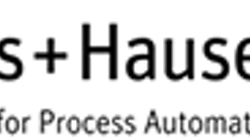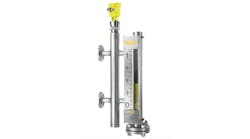Today’s smart instruments boast an array of functions and features beyond the nominal process variable (PV) that can make life better in myriad ways...or not, if you don’t take them into account. To talk about those other intangible deliverables that today’s smart level instruments can deliver, Keith Larson is joined by Scott Peterson, national product manager, level, and Keith Riley, national product manager, temperature and pressure, both of Endress+Hauser’s U.S. operations.
Transcript
Keith Larson: Because accurately measuring product level in a tank, silo or reactor can be quite demanding, the process instrumentation professional has at his or her disposal an impressive array of technologies based on just about every conceivable difference in measurable physical properties between two media. But nowadays, identifying appropriate technology that meets accuracy requirements for continuous level or detecting the presence of material at a particular point is really only the first step in choosing the best instrument for a given application. Indeed, today's smart instruments boast an array of functions and features beyond the nominal process variable that can make life better in myriad ways or not, if you don't take them into account.
Hello, this is Keith Larson, editor of Control magazine and controlglobal.com. And welcome to the Solutions Spotlight episode of our Control Amplified podcast, sponsored today by Endress+Hauser. With me today to talk about all those other intangible deliverables that today's smart level instruments can deliver are Scott Peterson, national product manager for Level, and Keith Riley, national product manager both of Endress+Hauser's U.S. operations. Scott, Keith, a real pleasure to have you with me today. Thanks for joining me.
Scott Peterson: Thank you.
Keith Riley: Thank you, Keith.
Keith Larson: Well, Scott, let's maybe start out by putting the current state of level instrumentation technology in context. I would argue that maybe by choosing a suitable technology that meets your accuracy requirements for a given application, it's a relatively easy first step. And further, if that's all you're interested in, why not, you know, take your pick of a number of quality instruments at a range of price points and take the cheapest one? Is there more to it than that?
Scott Peterson: Well, certainly if the measurement is a simple, straightforward application, cost may very well be one of the bigger drivers or considerations, and you'll typically have many different level technologies that'll yield satisfactory results. However, frequently, when more things come into play, other factors beyond measurement accuracy are going to be becoming more important. And on these applications, radar has become kind of a favored technology. And with that, how the radar signal is evaluated by the electronics, the utilization of digital signal processing, and even advanced algorithms for tracking are going to dictate the probability of success on your level of measurement.
The ability to filter out false echoes and optimize the PV tracking are only effective with this advanced functionality. And then, additionally, there's going to be smart features that can provide value beyond the simple process variable. One of these would be better diagnostics with clear messaging, both for the device as well as the loop it is in, and then also additional insight into the process itself with features such as foam detection or build-up detection.
Keith Larson: Yeah, I think radar technology has come a long way in the 30 years that I've been covering this industry. It used to be really just for expensive, high, actually, tank gauging type of custody transfer applications, but it's being used in a lot more types of applications nowadays, isn't it?
Scott Peterson: Certainly is. And we're enjoying a situation where not only is functionality getting better, but the price point has been coming down simultaneously. So it makes it a very, I guess, popular choice, both from performance and from value and cost.
Keith Larson: That makes sense. Well, Keith, maybe if I can turn to you, it seems most of the differentiation when it comes to today's smart instruments falls into three buckets, I guess, I would say features and functionality that contribute to improve safety, simpler work processes, and greater productivity. So those three, improved safety, simpler work processes, and greater productivity. So maybe if you could talk a little bit about improved safety, sort of a redundant setup or overfill protection switch, what capabilities aboard a smart level transmitter itself can contribute to improve safety from your perspective?
Keith Riley: Thank you, Keith. Well, let me start by saying, when I think of improved safety, I've got two categories, the process safety, which you referred to, and also personal safety. So I think there's two different things to look at. If we start with the process safety or safety instrumented system (SIS) or something like that, similar to your first question, to be honest, there's a lot of parity in the market. Any good manufacturer, your Lambda DU values from a safety standpoint are going to be extremely close.
So the real thing to think about is, how can I use this instrument to reduce my systematic failure or the risk of systematic failure, I should say, which is really more of a human error type aspect, which there's no preventing it from ever happening but you can mitigate it. And that's where some of the changes today come in. ELC, different functionality, like proof test wizards, easier ways of proof testing. Take a point level switch, for example. You can have multiple ways to do your proof testing. Some of it is as easy as pushing a button, which runs it through a cycle. Sometimes it's a magnetic coupling that does it. And as I said, you have your proof test wizard, which really addresses that systematic failure.
Think of the dozens, if not hundreds of instruments that are in an area with an SIS. Each one of them is going to have a slightly different proof test procedure and no technician is going to have them all memorized. So then he has to resort to a manual and back and forth reading it and hoping he doesn't get interrupted or something else happens. What you're finding implemented today is an instrument-guided procedure, which leads you through it. You're not actually making any changes to the instrument but it's asking you questions, "Did you check this?" "Yes." "What was the response?" You type it in.
So that it's leading you through that, making you sure you've done all the steps as identified in the functional safety manual, and what's even better is, at the end, then you can get a PDF of it. So you got a report automatically of what you just did. And it also means that at the end of the day after they've been, you know, maybe a dozen instruments, they don't have to rely on memory or somebody else's handwriting to make sure everything's filed properly. It's very easy just to transfer that PDF sheet.
Keith Larson: Yeah. That makes sense. The ability to do self-diagnostics and that sort of thing on a regular basis, does that also allow you to go to a broader test intervalin some cases so that you maybe don't have to visit that instrument quite as often?
Keith Riley: I think that's going to be a site-by-site determination and their calculation, but certainly some of the easier proof test procedures maybe do not have the coverage but can result in just what you're saying. They can link then the time in between a foolproof test, which obviously makes it more quick and arguably more simple and it doesn't take as much time.
Keith Larson: Makes a lot of sense. We were talking about simpler. You just mentioned simpler work process as well, which, you know, a less frequent proof test certainly qualifies. It's really a phrase, though, that can be applied throughout a level transmitter life cycle from installation and commissioning to operations, calibration and maintenance. Scott, maybe you could talk a little about what level of instrument features and functionality can make instrumentation professional's life easier at each stage of its life cycle.
Scott Peterson: Certainly, you're absolutely correct. There's benefits to be realized really throughout the life cycle of the device. You know, and when looking at installation and commissioning of devices and looking at common practice, what we've seen in the workplace is attrition of the workforce, combining with ever-increasing numbers of smart devices. And we see this creating challenges. Many of these devices have slightly different menu structures from one another, and then keeping manuals or even menu trees for handheld communicators can become a cumbersome task.
Menu hopping is problematic, knowing from which branch to which branch of the decision tree you're supposed to go. That creates issues for people and certainly not a simple process. The commissioning wizards that have come out as of late lend themselves to simplifying that setup process, eliminating the uncertainty, making it easy to set the necessary parameters. You have easy instrument-led directions. And as Keith mentioned earlier, Bluetooth is simplifying that process even further. You know, before Bluetooth, a typical service tech would have to locate a laptop or a handheld communicator, ensure the correct DTMs are loaded into the software, locate a modem that's the correct type to connect either at the device or out at our marshaling panel.
With Bluetooth, a lot of that goes away. You really only need a cell phone to do your connection. And looking at operations, we see their role simplified as well. Usually, error codes in the past were kind of undefined, hieroglyphic in nature. You had to look it up to even know what it meant with suggested instrument guides to take the steps. If you look at the smart devices today and what we're offering, you have clear English directions and, again, instrument-guided steps to take. And then, I guess, finally looking at calibration and maintenance, we see simplification there as well. Calibration wizards, partial proof test wizards, like Keith had mentioned earlier. Each step is guided with simple directions, and that's all taking place while providing record-keeping for the associated tasks as well.
Keith Larson: You mentioned about the Bluetooth. I can't help but imagine that if you're in a classified environment, you can actually, I'm assuming you have a classified environment, capable smartphone, you can check that and do diagnostics without having to declassify the area and do a shutdown or do that sort of thing as well. So that would seem to me to certainly enhance productivity as well.
Scott Peterson: Certainly.
Keith Larson: But, Keith, improve productivity, that's our third or our fourth, third on the list. It seems like, to me, that has two contexts. One that applies to the productivity of personnel. And the second that really applies to the production processes at hand, such as through avoiding unscheduled downtime. How can one's choice of level transmitter contribute to improvements in both of these fears, both the productivity of personnel, as well as the productivity of processes, frankly?
Keith Riley: All right, Keith, well, that usually falls into one of three areas, which I'll state here first. One is the diagnostics, one is verification, and one is monitoring or predictive maintenance. Scott already touched a bit on the diagnostics, as he said, there's better diagnostics. A typical scenario in the past would have been, you're using your 4 to 20 signal. You get an alarm warning back to control system. You have to send out a technician to go find the instrument that's sending that warning, find out what the diagnostic code on that is. And you're radioing back to the control system. "Okay. This is what the diagnostic code is. Can you find the manual and look up to see what the problem is so that we can deal with it?" Assuming you have the manual handy and all sorts of things.
In today's world with these advanced diagnostics, not only are you getting an error code, you're also having a dashboard-type of a warning where it tells you, is it truly a warning or an alarm, or is it more of a, "Hey, you're going to have a maintenance issue coming up and it's not a problem. You don't have to worry about it immediately"? And it's giving you some of that information in plain English. And as Scott also said, the great part is even standing right there at the instrument, either through the Bluetooth or through the local display, with a couple of pushes of a button, you can track down and be told, "Here's what your likely solution to this issue is," so you can deal with it right then and there.
So that's a whole lot of productivity. You can cut down into a much smaller window the amount of time you have to deal with that, or if you have to deal with it at all right at that point, or if it's something you can wait and put into your regular maintenance schedule in the next couple of days. So that's a big savings.
Keith Larson: And it seems those diagnostics are going beyond just stuff that might be wrong or wonky with the device but also with the process itself, if there's excessive foaming, or if you've got, you know, a buildup on the gauge. Those kinds of diagnostics seem like they can really help head off problems early as well.
Keith Riley: Exactly. And you just touched on the whole monitoring and the predictive maintenance at that particular point. Getting back to that whole idea that there's a whole lot of information that that instrument is seeing that is not directly associated with the primary value or the measurement value signals strength. Perfect example of what you're talking about for foaming. Can you monitor the signal strength and set thresholds? But once it starts to drop off can be an indication that you have foaming taking place.
Most customers already know whether or not that process is prone to that kind of situation. And by setting those thresholds, which the instrument can then alert you about, you can see, "Am I getting to the point where that's going to be a problem?" And again, you can control your maintenance cycle that way. Instead of everything being reactive, you're being preventative or forward-thinking about when you have to get out and deal with it. The last one is what I'm going to call verification. And I'm careful with that. I'm not talking calibration, I'm talking verification of the device, which is a quantitative assessment, not a qualitative assessment.
And for most of the Endress+Hauser instruments with this capability, you're doing a check of the electronics. You're gauging it against the specifications of those electronics when the instrument was new and it's telling you, "Yes, it's still within spec. No, it's not." But the nice part about that is once you've done that with a high percentage of total test coverage well into the 90th percentile, you have a high degree of confidence that the unit is still working. So that's a great put your mind to ease, I guess, is the best way to put it.
The great thing about this is, though, and this was the productivity discussion that happens in situ, you don't have to take anything out of service. You don't have to pull it out of the tank, break the seal on a vessel or a pipe, or anything else. And it doesn't interfere with the signal going back to the control room. So there's no interruption in your actual measurement while this is taking place. So it approaches that whole productivity from a couple of different perspectives.
Keith Larson: Yeah. That makes perfect sense. Overall, do you feel like the value proposition around the life cycle proposition for level instrumentation is getting more of a listen nowadays versus, you know, the upfront instrument costs from your client's perspective? Has that changed any over the years?
Keith Riley: I think there's a great emphasis on value. And I'm going to say that versus the cost is, is this instrument giving me additional information, ways that I can manage my process better, that is bringing greater value to the process as a whole? I think that is how it's being looked at by most customers today. Well beyond just the measurement itself.
Keith Larson: Great. But I think we've come to the end of our planned allotted time. So with that, I really want to thank you both so much for sharing your insights with us all today.
For those of you listening, thanks also for tuning in, and thanks also to Endress+Hauser for sponsoring this episode. I'm Keith Larson. You've been listening to Control Amplified podcast. Joining me today has been Scott Peterson, national product manager, level, and Keith Riley, national product manager, both of Endress+Hauser's U.S. operations. If you've enjoyed this episode, you can subscribe at the iTunes store and the Google Podcasts. Plus, you can find the full archive of past episodes at controlglobal.com. Signing off, until next time. And again, thanks again, Scott, thanks, Keith. Really appreciate you joining me today.
Scott Peterson: Thank you.
Keith Riley: Thank you, Keith.
Keith Larson: Take care.
For more, tune into Control Amplified: The Process Automation Podcast.




